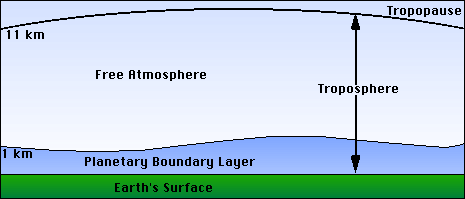Planetary boundary layer
As Peplosphäre (or as a base layer, planetary / atmospheric boundary layer (english atmospheric boundary layer ) or friction layer, literally air " garment" of the earth's surface, cf peplos ) is the part of Earth's atmosphere called, by the turbulence- causing properties of the Earth's surface ( and in particular heating surface friction ) is influenced in the time domain of hours. Typically, these are the lowest 1.5 to 2 kilometers.
Special
In the basic layer of the primary engine of the weather is. Here the energy radiation of the sun appears (visible light, see solar constant ) large effects as well as the radiation upward ( light and infrared). This makes it the most turbulent layer of the atmosphere with a large proportion of convection. Different albedo of the earth's surface - for example by vegetation and slope of the land - leading to local assembly, hang- and downdrafts, particularly among and between the clouds ( see gliding ).
The Peplosphäre is - in contrast to the larger part of the overlying troposphere ( free atmosphere ) - characterized in that the geostrophic wind is slowed by bottom friction. This makes it no longer blows as at higher altitudes, parallel to the isobars, but rather towards the lower air pressure. The inflow surface air in the low pressure areas is compensated by aliquot compensating winch just below the tropopause. Some deviating from the free atmosphere temperature and especially wind effects of Peplosphäre be compensated at higher altitudes near the tropopause by opposing winds.
In the Peplosphäre it often comes to form a haze layer by buildup of aerosols. Climbers can see the top of the Peplosphäre when the valleys are in the early morning fog, the higher mountain slopes but already in the sunshine. Even when flying in a few minutes after the start of this boundary layer lifts off the sky blue. In so-called radiation periods ( clear sky ) this atmosphere region shows a strong nocturnal cooling by thermal radiation into space, forming haze and also long-lasting high fog may form.










